Comprehensive Report: Performance of NTUC Company Objectives
VerifiedAdded on 2021/05/31
|26
|4997
|27
Report
AI Summary
This report provides a comprehensive analysis of NTUC's performance, focusing on its operational management, customer experience, and strategic responses to market challenges. The report begins by examining the essential components for effective operations management at NTUC, including supply chain, efficiency, reliability, flexibility, and quality control. It then explores the reasons behind online shopping trends at NTUC and the problems the company faces when changing its business model. The report delves into appropriate operational models, NTUC's response to parcel delivery issues, and strategies to enhance customer experiences through digital platforms and improved services. The analysis includes a detailed look at the company's performance objectives, operations priorities, and resource implementation for a new business process, supported by a Balanced Scorecard perspective. The report also incorporates visual aids like Rich Pictures, Root Definitions, CATWOE analysis, and Business Process Model and Notation (BPMN) diagrams (AS IS and TO BE), to illustrate and analyze the company's current state and future plans. The conclusion highlights key strategies for improved customer satisfaction and operational efficiency.
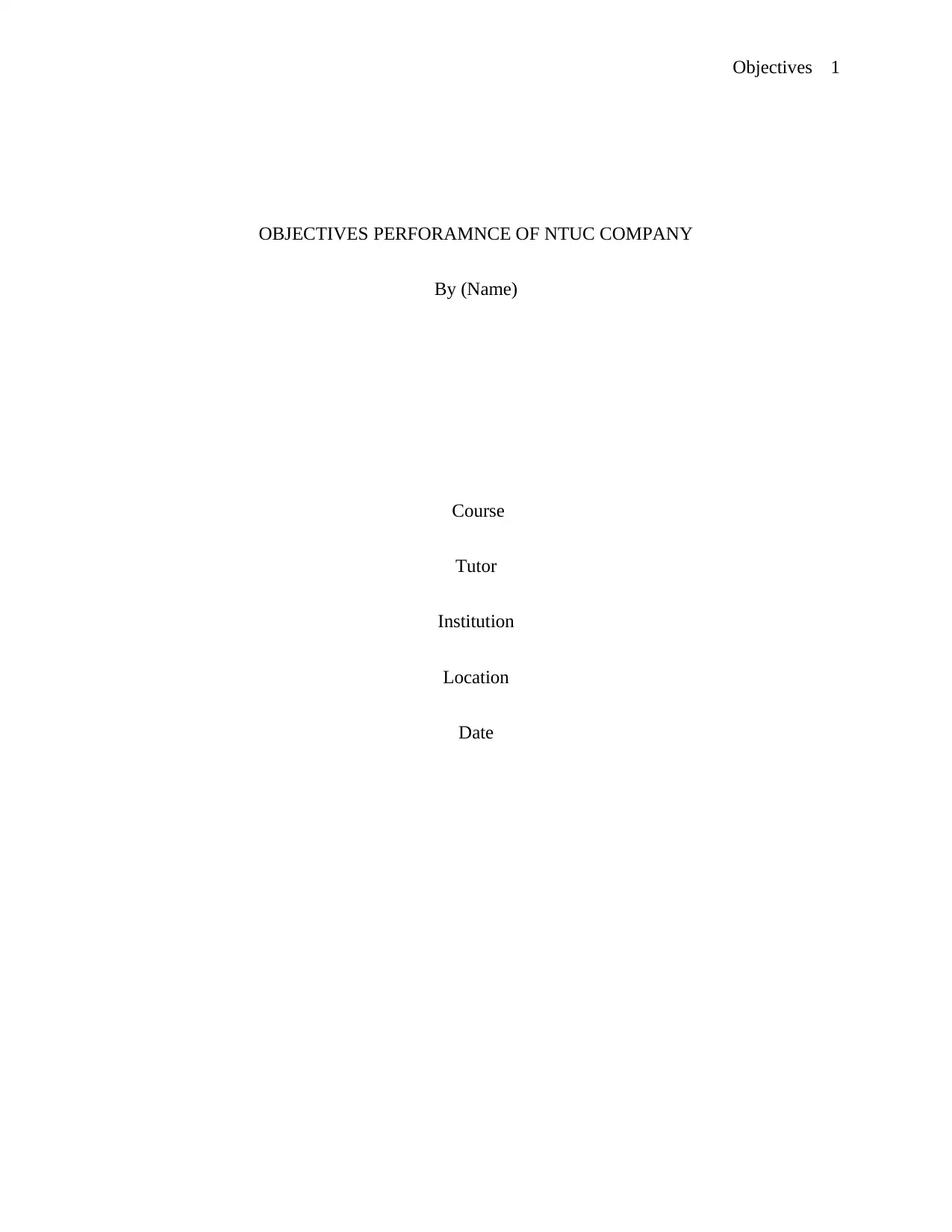
Objectives 1
OBJECTIVES PERFORAMNCE OF NTUC COMPANY
By (Name)
Course
Tutor
Institution
Location
Date
OBJECTIVES PERFORAMNCE OF NTUC COMPANY
By (Name)
Course
Tutor
Institution
Location
Date
Paraphrase This Document
Need a fresh take? Get an instant paraphrase of this document with our AI Paraphraser
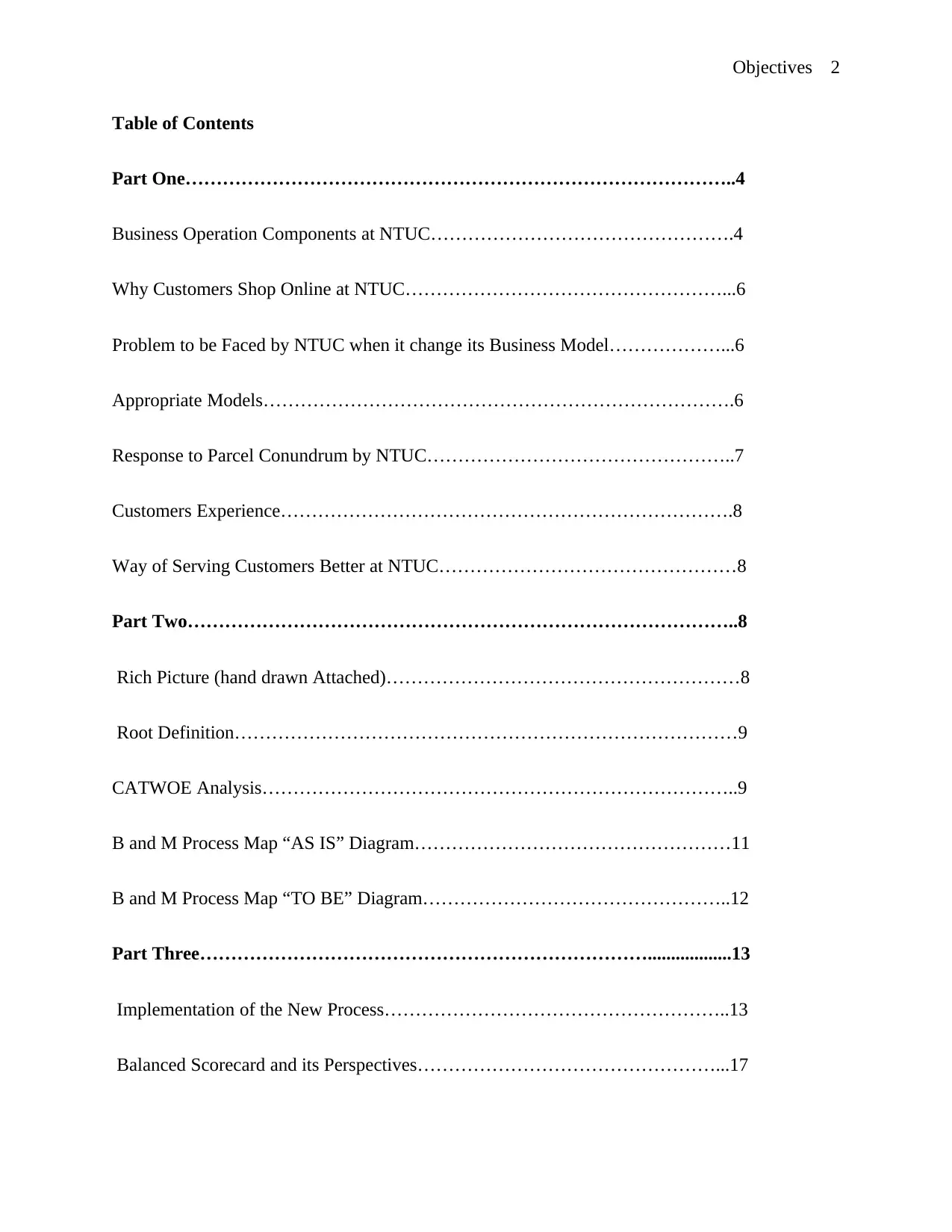
Objectives 2
Table of Contents
Part One……………………………………………………………………………..4
Business Operation Components at NTUC………………………………………….4
Why Customers Shop Online at NTUC……………………………………………...6
Problem to be Faced by NTUC when it change its Business Model………………...6
Appropriate Models………………………………………………………………….6
Response to Parcel Conundrum by NTUC…………………………………………..7
Customers Experience……………………………………………………………….8
Way of Serving Customers Better at NTUC…………………………………………8
Part Two……………………………………………………………………………..8
Rich Picture (hand drawn Attached)…………………………………………………8
Root Definition………………………………………………………………………9
CATWOE Analysis…………………………………………………………………..9
B and M Process Map “AS IS” Diagram……………………………………………11
B and M Process Map “TO BE” Diagram…………………………………………..12
Part Three………………………………………………………………..................13
Implementation of the New Process………………………………………………..13
Balanced Scorecard and its Perspectives…………………………………………...17
Table of Contents
Part One……………………………………………………………………………..4
Business Operation Components at NTUC………………………………………….4
Why Customers Shop Online at NTUC……………………………………………...6
Problem to be Faced by NTUC when it change its Business Model………………...6
Appropriate Models………………………………………………………………….6
Response to Parcel Conundrum by NTUC…………………………………………..7
Customers Experience……………………………………………………………….8
Way of Serving Customers Better at NTUC…………………………………………8
Part Two……………………………………………………………………………..8
Rich Picture (hand drawn Attached)…………………………………………………8
Root Definition………………………………………………………………………9
CATWOE Analysis…………………………………………………………………..9
B and M Process Map “AS IS” Diagram……………………………………………11
B and M Process Map “TO BE” Diagram…………………………………………..12
Part Three………………………………………………………………..................13
Implementation of the New Process………………………………………………..13
Balanced Scorecard and its Perspectives…………………………………………...17
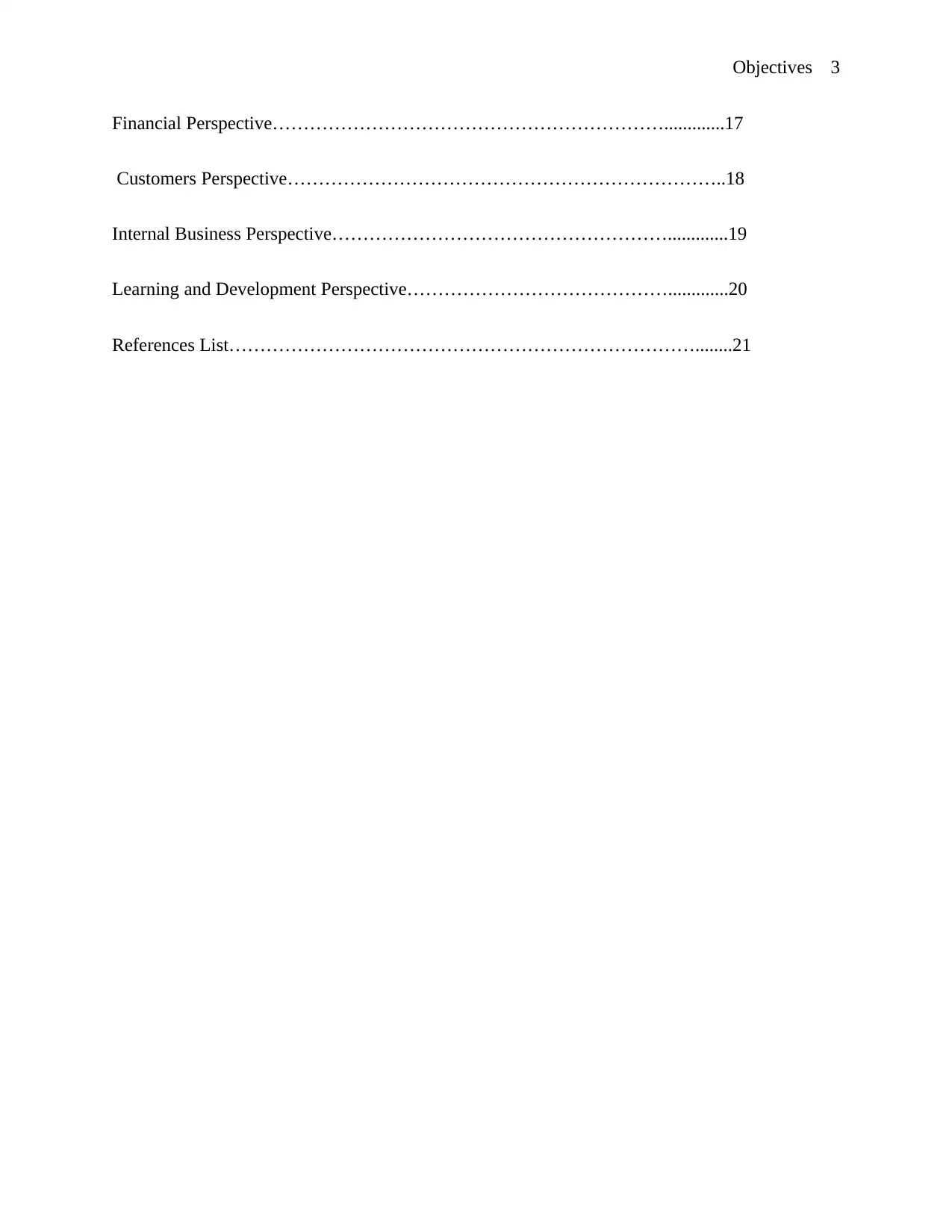
Objectives 3
Financial Perspective……………………………………………………….............17
Customers Perspective……………………………………………………………..18
Internal Business Perspective……………………………………………….............19
Learning and Development Perspective…………………………………….............20
References List…………………………………………………………………........21
Financial Perspective……………………………………………………….............17
Customers Perspective……………………………………………………………..18
Internal Business Perspective……………………………………………….............19
Learning and Development Perspective…………………………………….............20
References List…………………………………………………………………........21
⊘ This is a preview!⊘
Do you want full access?
Subscribe today to unlock all pages.

Trusted by 1+ million students worldwide
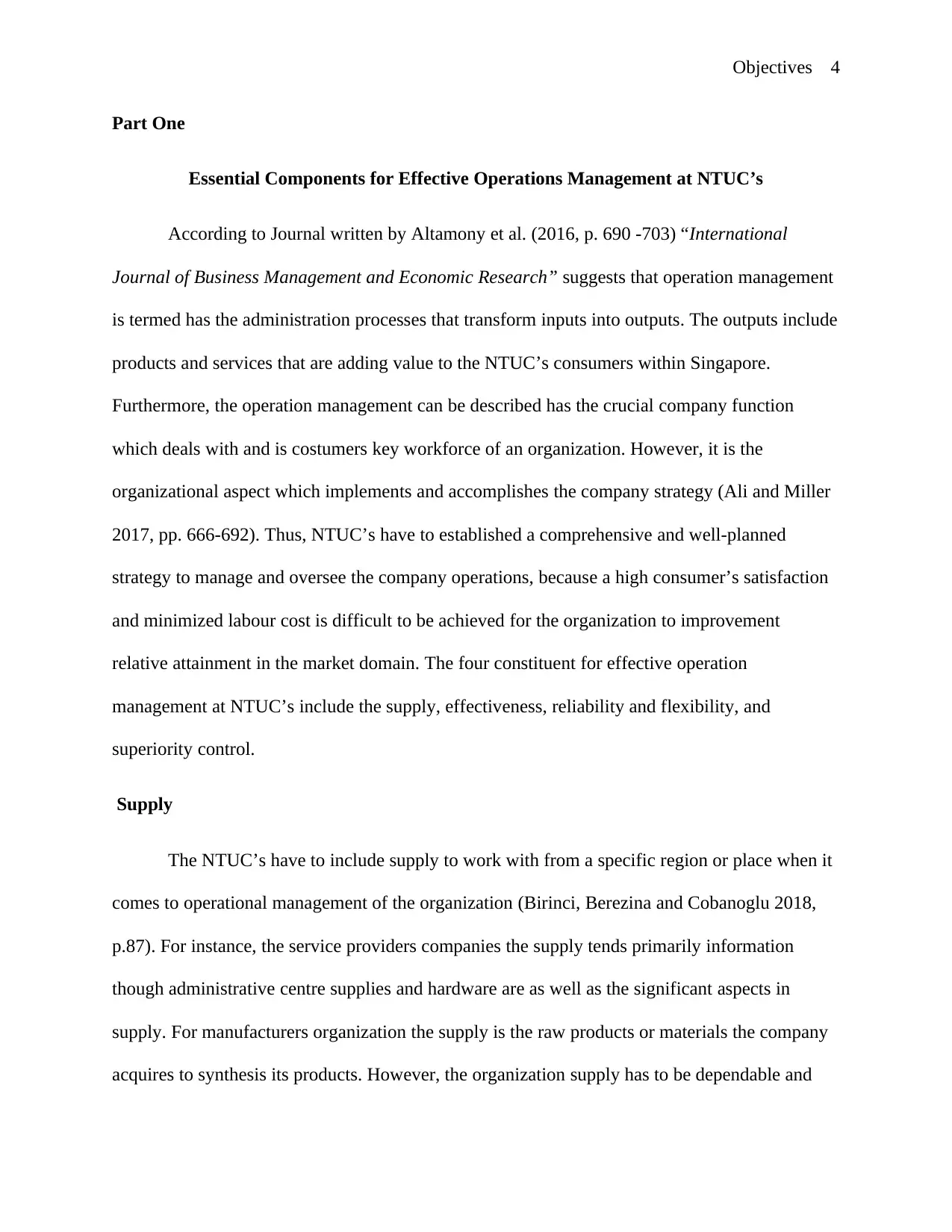
Objectives 4
Part One
Essential Components for Effective Operations Management at NTUC’s
According to Journal written by Altamony et al. (2016, p. 690 -703) “International
Journal of Business Management and Economic Research” suggests that operation management
is termed has the administration processes that transform inputs into outputs. The outputs include
products and services that are adding value to the NTUC’s consumers within Singapore.
Furthermore, the operation management can be described has the crucial company function
which deals with and is costumers key workforce of an organization. However, it is the
organizational aspect which implements and accomplishes the company strategy (Ali and Miller
2017, pp. 666-692). Thus, NTUC’s have to established a comprehensive and well-planned
strategy to manage and oversee the company operations, because a high consumer’s satisfaction
and minimized labour cost is difficult to be achieved for the organization to improvement
relative attainment in the market domain. The four constituent for effective operation
management at NTUC’s include the supply, effectiveness, reliability and flexibility, and
superiority control.
Supply
The NTUC’s have to include supply to work with from a specific region or place when it
comes to operational management of the organization (Birinci, Berezina and Cobanoglu 2018,
p.87). For instance, the service providers companies the supply tends primarily information
though administrative centre supplies and hardware are as well as the significant aspects in
supply. For manufacturers organization the supply is the raw products or materials the company
acquires to synthesis its products. However, the organization supply has to be dependable and
Part One
Essential Components for Effective Operations Management at NTUC’s
According to Journal written by Altamony et al. (2016, p. 690 -703) “International
Journal of Business Management and Economic Research” suggests that operation management
is termed has the administration processes that transform inputs into outputs. The outputs include
products and services that are adding value to the NTUC’s consumers within Singapore.
Furthermore, the operation management can be described has the crucial company function
which deals with and is costumers key workforce of an organization. However, it is the
organizational aspect which implements and accomplishes the company strategy (Ali and Miller
2017, pp. 666-692). Thus, NTUC’s have to established a comprehensive and well-planned
strategy to manage and oversee the company operations, because a high consumer’s satisfaction
and minimized labour cost is difficult to be achieved for the organization to improvement
relative attainment in the market domain. The four constituent for effective operation
management at NTUC’s include the supply, effectiveness, reliability and flexibility, and
superiority control.
Supply
The NTUC’s have to include supply to work with from a specific region or place when it
comes to operational management of the organization (Birinci, Berezina and Cobanoglu 2018,
p.87). For instance, the service providers companies the supply tends primarily information
though administrative centre supplies and hardware are as well as the significant aspects in
supply. For manufacturers organization the supply is the raw products or materials the company
acquires to synthesis its products. However, the organization supply has to be dependable and
Paraphrase This Document
Need a fresh take? Get an instant paraphrase of this document with our AI Paraphraser
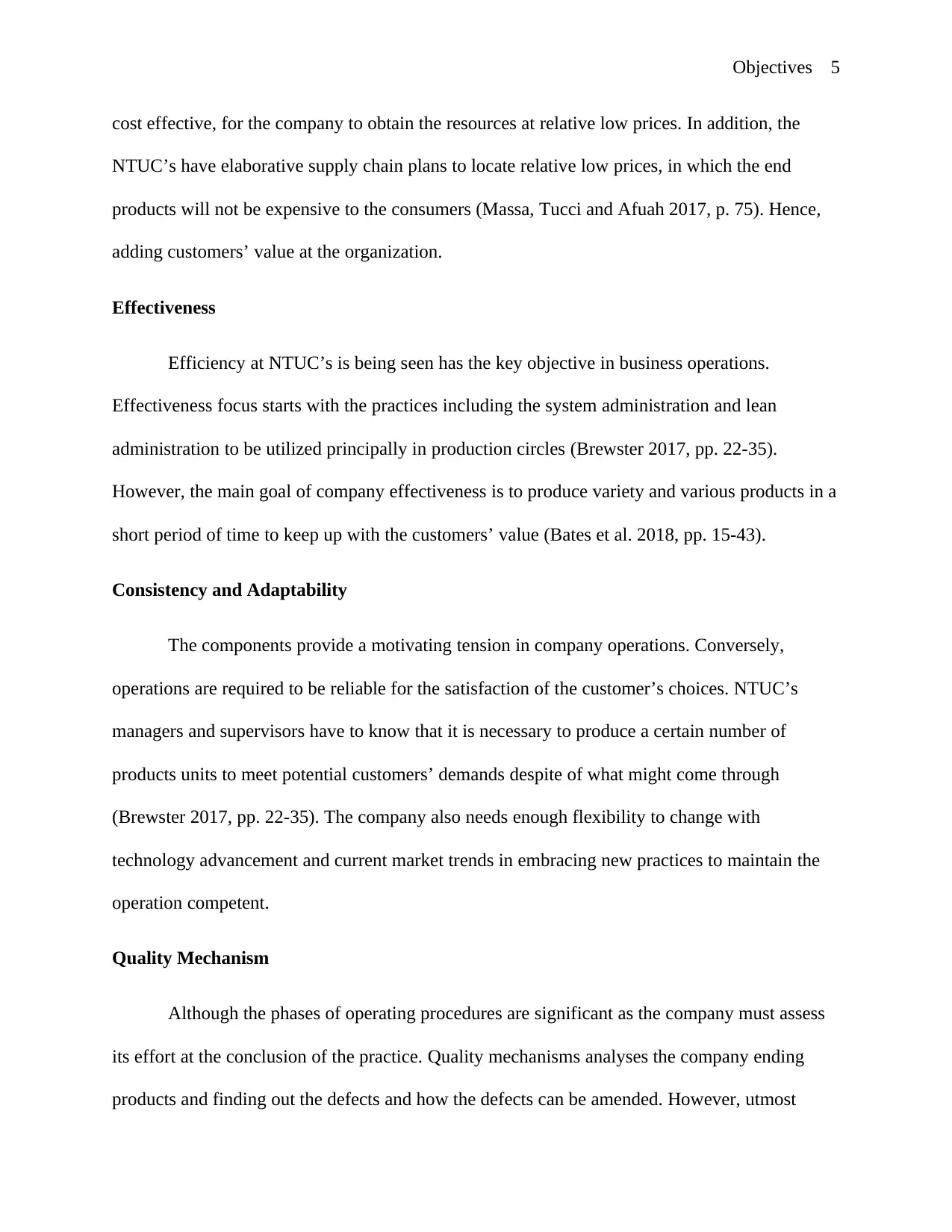
Objectives 5
cost effective, for the company to obtain the resources at relative low prices. In addition, the
NTUC’s have elaborative supply chain plans to locate relative low prices, in which the end
products will not be expensive to the consumers (Massa, Tucci and Afuah 2017, p. 75). Hence,
adding customers’ value at the organization.
Effectiveness
Efficiency at NTUC’s is being seen has the key objective in business operations.
Effectiveness focus starts with the practices including the system administration and lean
administration to be utilized principally in production circles (Brewster 2017, pp. 22-35).
However, the main goal of company effectiveness is to produce variety and various products in a
short period of time to keep up with the customers’ value (Bates et al. 2018, pp. 15-43).
Consistency and Adaptability
The components provide a motivating tension in company operations. Conversely,
operations are required to be reliable for the satisfaction of the customer’s choices. NTUC’s
managers and supervisors have to know that it is necessary to produce a certain number of
products units to meet potential customers’ demands despite of what might come through
(Brewster 2017, pp. 22-35). The company also needs enough flexibility to change with
technology advancement and current market trends in embracing new practices to maintain the
operation competent.
Quality Mechanism
Although the phases of operating procedures are significant as the company must assess
its effort at the conclusion of the practice. Quality mechanisms analyses the company ending
products and finding out the defects and how the defects can be amended. However, utmost
cost effective, for the company to obtain the resources at relative low prices. In addition, the
NTUC’s have elaborative supply chain plans to locate relative low prices, in which the end
products will not be expensive to the consumers (Massa, Tucci and Afuah 2017, p. 75). Hence,
adding customers’ value at the organization.
Effectiveness
Efficiency at NTUC’s is being seen has the key objective in business operations.
Effectiveness focus starts with the practices including the system administration and lean
administration to be utilized principally in production circles (Brewster 2017, pp. 22-35).
However, the main goal of company effectiveness is to produce variety and various products in a
short period of time to keep up with the customers’ value (Bates et al. 2018, pp. 15-43).
Consistency and Adaptability
The components provide a motivating tension in company operations. Conversely,
operations are required to be reliable for the satisfaction of the customer’s choices. NTUC’s
managers and supervisors have to know that it is necessary to produce a certain number of
products units to meet potential customers’ demands despite of what might come through
(Brewster 2017, pp. 22-35). The company also needs enough flexibility to change with
technology advancement and current market trends in embracing new practices to maintain the
operation competent.
Quality Mechanism
Although the phases of operating procedures are significant as the company must assess
its effort at the conclusion of the practice. Quality mechanisms analyses the company ending
products and finding out the defects and how the defects can be amended. However, utmost
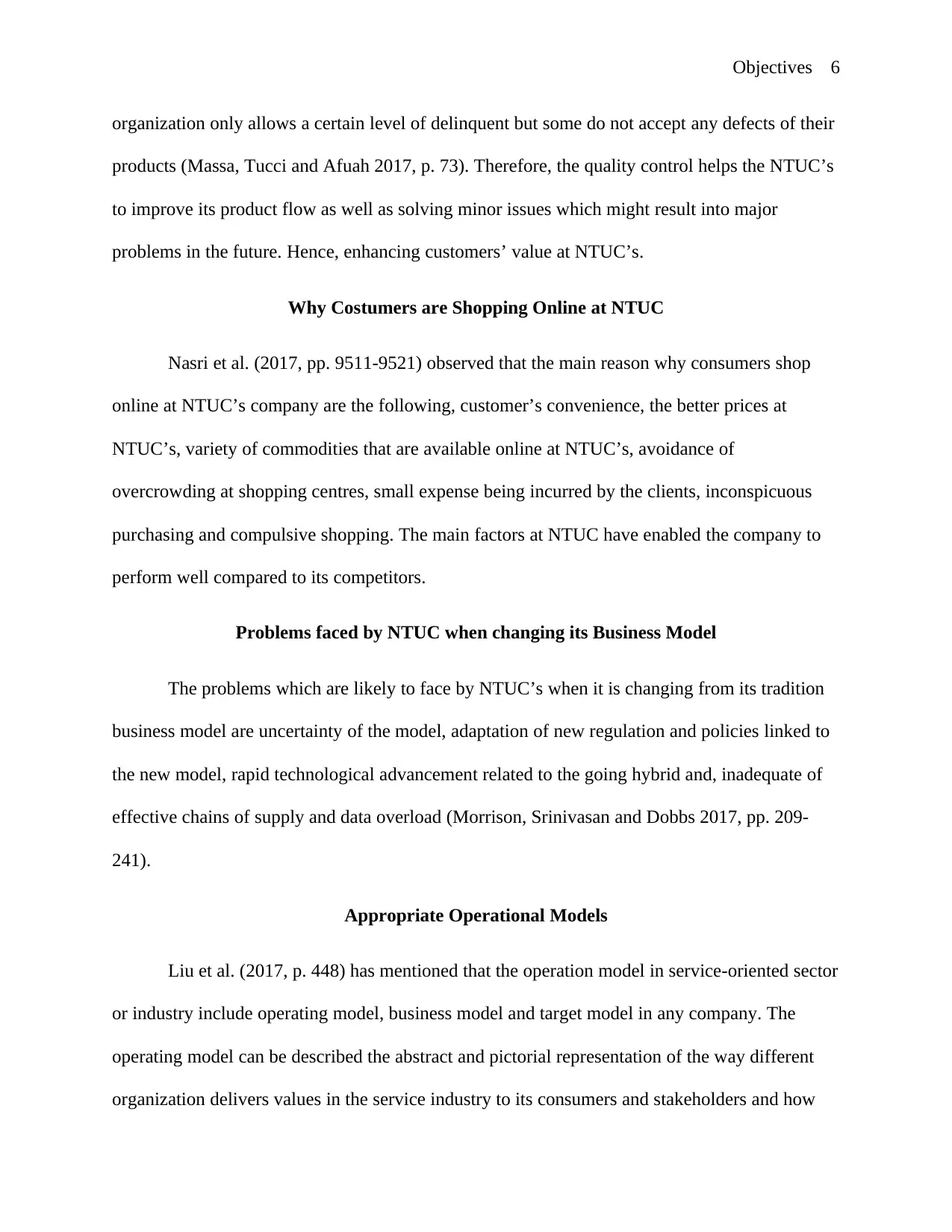
Objectives 6
organization only allows a certain level of delinquent but some do not accept any defects of their
products (Massa, Tucci and Afuah 2017, p. 73). Therefore, the quality control helps the NTUC’s
to improve its product flow as well as solving minor issues which might result into major
problems in the future. Hence, enhancing customers’ value at NTUC’s.
Why Costumers are Shopping Online at NTUC
Nasri et al. (2017, pp. 9511-9521) observed that the main reason why consumers shop
online at NTUC’s company are the following, customer’s convenience, the better prices at
NTUC’s, variety of commodities that are available online at NTUC’s, avoidance of
overcrowding at shopping centres, small expense being incurred by the clients, inconspicuous
purchasing and compulsive shopping. The main factors at NTUC have enabled the company to
perform well compared to its competitors.
Problems faced by NTUC when changing its Business Model
The problems which are likely to face by NTUC’s when it is changing from its tradition
business model are uncertainty of the model, adaptation of new regulation and policies linked to
the new model, rapid technological advancement related to the going hybrid and, inadequate of
effective chains of supply and data overload (Morrison, Srinivasan and Dobbs 2017, pp. 209-
241).
Appropriate Operational Models
Liu et al. (2017, p. 448) has mentioned that the operation model in service-oriented sector
or industry include operating model, business model and target model in any company. The
operating model can be described the abstract and pictorial representation of the way different
organization delivers values in the service industry to its consumers and stakeholders and how
organization only allows a certain level of delinquent but some do not accept any defects of their
products (Massa, Tucci and Afuah 2017, p. 73). Therefore, the quality control helps the NTUC’s
to improve its product flow as well as solving minor issues which might result into major
problems in the future. Hence, enhancing customers’ value at NTUC’s.
Why Costumers are Shopping Online at NTUC
Nasri et al. (2017, pp. 9511-9521) observed that the main reason why consumers shop
online at NTUC’s company are the following, customer’s convenience, the better prices at
NTUC’s, variety of commodities that are available online at NTUC’s, avoidance of
overcrowding at shopping centres, small expense being incurred by the clients, inconspicuous
purchasing and compulsive shopping. The main factors at NTUC have enabled the company to
perform well compared to its competitors.
Problems faced by NTUC when changing its Business Model
The problems which are likely to face by NTUC’s when it is changing from its tradition
business model are uncertainty of the model, adaptation of new regulation and policies linked to
the new model, rapid technological advancement related to the going hybrid and, inadequate of
effective chains of supply and data overload (Morrison, Srinivasan and Dobbs 2017, pp. 209-
241).
Appropriate Operational Models
Liu et al. (2017, p. 448) has mentioned that the operation model in service-oriented sector
or industry include operating model, business model and target model in any company. The
operating model can be described the abstract and pictorial representation of the way different
organization delivers values in the service industry to its consumers and stakeholders and how
⊘ This is a preview!⊘
Do you want full access?
Subscribe today to unlock all pages.

Trusted by 1+ million students worldwide
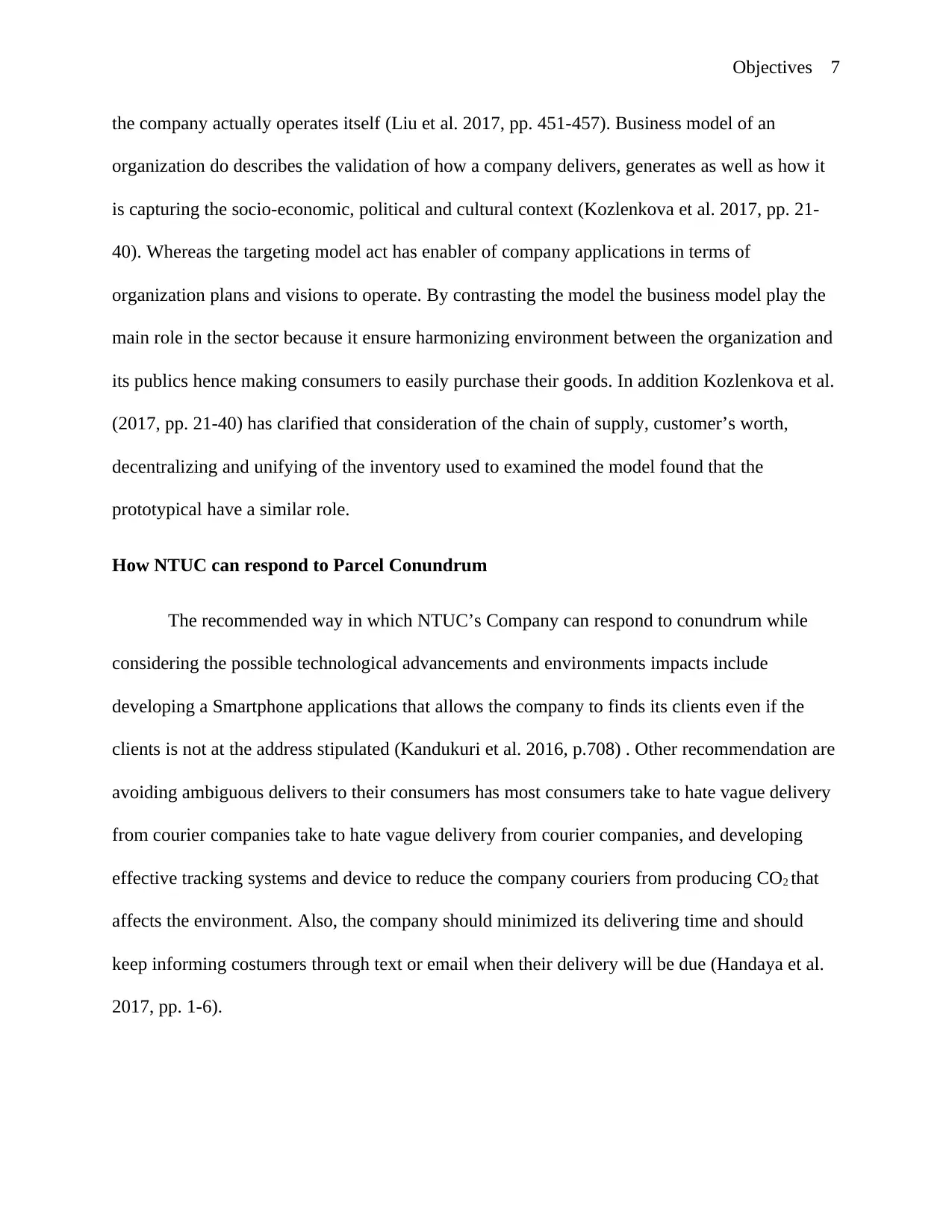
Objectives 7
the company actually operates itself (Liu et al. 2017, pp. 451-457). Business model of an
organization do describes the validation of how a company delivers, generates as well as how it
is capturing the socio-economic, political and cultural context (Kozlenkova et al. 2017, pp. 21-
40). Whereas the targeting model act has enabler of company applications in terms of
organization plans and visions to operate. By contrasting the model the business model play the
main role in the sector because it ensure harmonizing environment between the organization and
its publics hence making consumers to easily purchase their goods. In addition Kozlenkova et al.
(2017, pp. 21-40) has clarified that consideration of the chain of supply, customer’s worth,
decentralizing and unifying of the inventory used to examined the model found that the
prototypical have a similar role.
How NTUC can respond to Parcel Conundrum
The recommended way in which NTUC’s Company can respond to conundrum while
considering the possible technological advancements and environments impacts include
developing a Smartphone applications that allows the company to finds its clients even if the
clients is not at the address stipulated (Kandukuri et al. 2016, p.708) . Other recommendation are
avoiding ambiguous delivers to their consumers has most consumers take to hate vague delivery
from courier companies take to hate vague delivery from courier companies, and developing
effective tracking systems and device to reduce the company couriers from producing CO2 that
affects the environment. Also, the company should minimized its delivering time and should
keep informing costumers through text or email when their delivery will be due (Handaya et al.
2017, pp. 1-6).
the company actually operates itself (Liu et al. 2017, pp. 451-457). Business model of an
organization do describes the validation of how a company delivers, generates as well as how it
is capturing the socio-economic, political and cultural context (Kozlenkova et al. 2017, pp. 21-
40). Whereas the targeting model act has enabler of company applications in terms of
organization plans and visions to operate. By contrasting the model the business model play the
main role in the sector because it ensure harmonizing environment between the organization and
its publics hence making consumers to easily purchase their goods. In addition Kozlenkova et al.
(2017, pp. 21-40) has clarified that consideration of the chain of supply, customer’s worth,
decentralizing and unifying of the inventory used to examined the model found that the
prototypical have a similar role.
How NTUC can respond to Parcel Conundrum
The recommended way in which NTUC’s Company can respond to conundrum while
considering the possible technological advancements and environments impacts include
developing a Smartphone applications that allows the company to finds its clients even if the
clients is not at the address stipulated (Kandukuri et al. 2016, p.708) . Other recommendation are
avoiding ambiguous delivers to their consumers has most consumers take to hate vague delivery
from courier companies take to hate vague delivery from courier companies, and developing
effective tracking systems and device to reduce the company couriers from producing CO2 that
affects the environment. Also, the company should minimized its delivering time and should
keep informing costumers through text or email when their delivery will be due (Handaya et al.
2017, pp. 1-6).
Paraphrase This Document
Need a fresh take? Get an instant paraphrase of this document with our AI Paraphraser
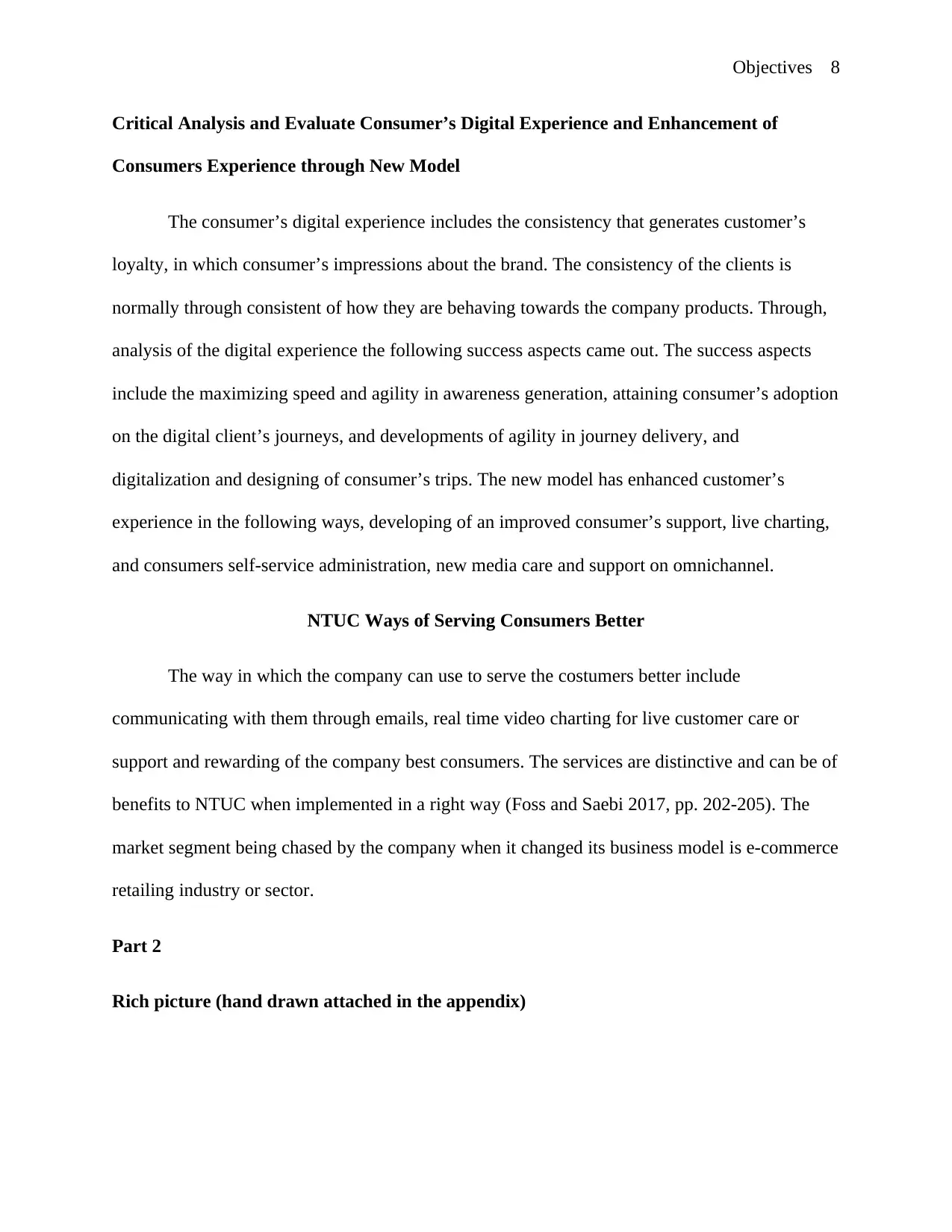
Objectives 8
Critical Analysis and Evaluate Consumer’s Digital Experience and Enhancement of
Consumers Experience through New Model
The consumer’s digital experience includes the consistency that generates customer’s
loyalty, in which consumer’s impressions about the brand. The consistency of the clients is
normally through consistent of how they are behaving towards the company products. Through,
analysis of the digital experience the following success aspects came out. The success aspects
include the maximizing speed and agility in awareness generation, attaining consumer’s adoption
on the digital client’s journeys, and developments of agility in journey delivery, and
digitalization and designing of consumer’s trips. The new model has enhanced customer’s
experience in the following ways, developing of an improved consumer’s support, live charting,
and consumers self-service administration, new media care and support on omnichannel.
NTUC Ways of Serving Consumers Better
The way in which the company can use to serve the costumers better include
communicating with them through emails, real time video charting for live customer care or
support and rewarding of the company best consumers. The services are distinctive and can be of
benefits to NTUC when implemented in a right way (Foss and Saebi 2017, pp. 202-205). The
market segment being chased by the company when it changed its business model is e-commerce
retailing industry or sector.
Part 2
Rich picture (hand drawn attached in the appendix)
Critical Analysis and Evaluate Consumer’s Digital Experience and Enhancement of
Consumers Experience through New Model
The consumer’s digital experience includes the consistency that generates customer’s
loyalty, in which consumer’s impressions about the brand. The consistency of the clients is
normally through consistent of how they are behaving towards the company products. Through,
analysis of the digital experience the following success aspects came out. The success aspects
include the maximizing speed and agility in awareness generation, attaining consumer’s adoption
on the digital client’s journeys, and developments of agility in journey delivery, and
digitalization and designing of consumer’s trips. The new model has enhanced customer’s
experience in the following ways, developing of an improved consumer’s support, live charting,
and consumers self-service administration, new media care and support on omnichannel.
NTUC Ways of Serving Consumers Better
The way in which the company can use to serve the costumers better include
communicating with them through emails, real time video charting for live customer care or
support and rewarding of the company best consumers. The services are distinctive and can be of
benefits to NTUC when implemented in a right way (Foss and Saebi 2017, pp. 202-205). The
market segment being chased by the company when it changed its business model is e-commerce
retailing industry or sector.
Part 2
Rich picture (hand drawn attached in the appendix)
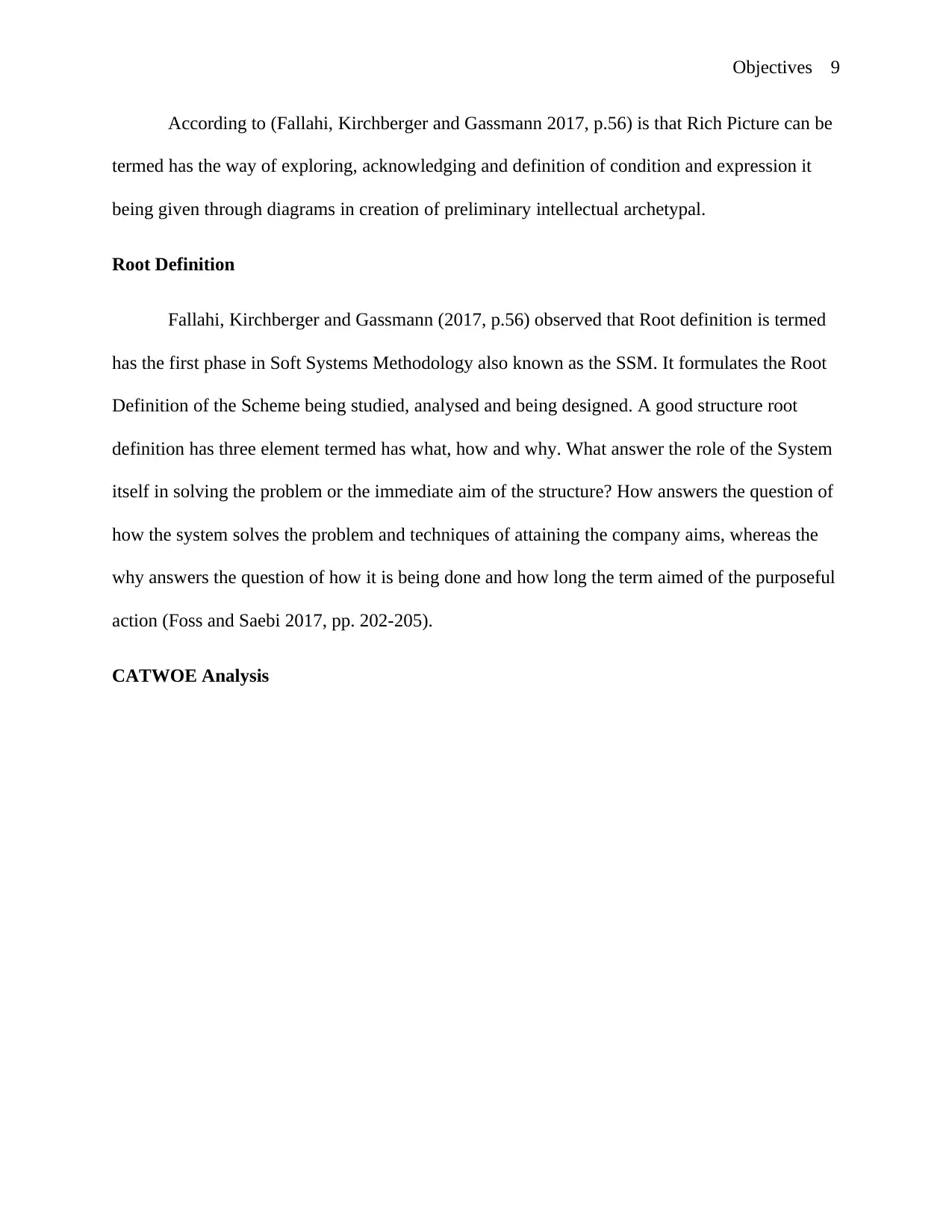
Objectives 9
According to (Fallahi, Kirchberger and Gassmann 2017, p.56) is that Rich Picture can be
termed has the way of exploring, acknowledging and definition of condition and expression it
being given through diagrams in creation of preliminary intellectual archetypal.
Root Definition
Fallahi, Kirchberger and Gassmann (2017, p.56) observed that Root definition is termed
has the first phase in Soft Systems Methodology also known as the SSM. It formulates the Root
Definition of the Scheme being studied, analysed and being designed. A good structure root
definition has three element termed has what, how and why. What answer the role of the System
itself in solving the problem or the immediate aim of the structure? How answers the question of
how the system solves the problem and techniques of attaining the company aims, whereas the
why answers the question of how it is being done and how long the term aimed of the purposeful
action (Foss and Saebi 2017, pp. 202-205).
CATWOE Analysis
According to (Fallahi, Kirchberger and Gassmann 2017, p.56) is that Rich Picture can be
termed has the way of exploring, acknowledging and definition of condition and expression it
being given through diagrams in creation of preliminary intellectual archetypal.
Root Definition
Fallahi, Kirchberger and Gassmann (2017, p.56) observed that Root definition is termed
has the first phase in Soft Systems Methodology also known as the SSM. It formulates the Root
Definition of the Scheme being studied, analysed and being designed. A good structure root
definition has three element termed has what, how and why. What answer the role of the System
itself in solving the problem or the immediate aim of the structure? How answers the question of
how the system solves the problem and techniques of attaining the company aims, whereas the
why answers the question of how it is being done and how long the term aimed of the purposeful
action (Foss and Saebi 2017, pp. 202-205).
CATWOE Analysis
⊘ This is a preview!⊘
Do you want full access?
Subscribe today to unlock all pages.

Trusted by 1+ million students worldwide
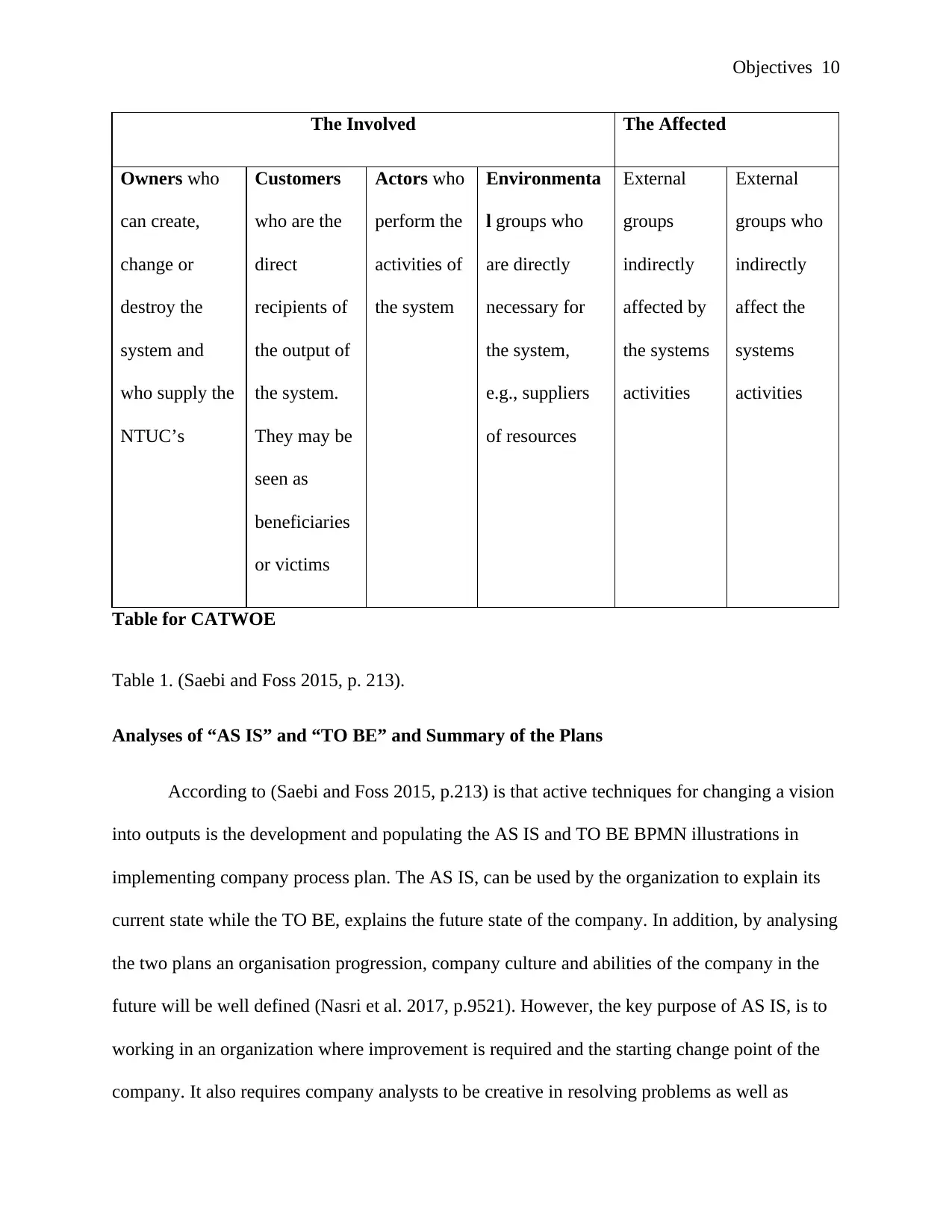
Objectives 10
The Involved The Affected
Owners who
can create,
change or
destroy the
system and
who supply the
NTUC’s
Customers
who are the
direct
recipients of
the output of
the system.
They may be
seen as
beneficiaries
or victims
Actors who
perform the
activities of
the system
Environmenta
l groups who
are directly
necessary for
the system,
e.g., suppliers
of resources
External
groups
indirectly
affected by
the systems
activities
External
groups who
indirectly
affect the
systems
activities
Table for CATWOE
Table 1. (Saebi and Foss 2015, p. 213).
Analyses of “AS IS” and “TO BE” and Summary of the Plans
According to (Saebi and Foss 2015, p.213) is that active techniques for changing a vision
into outputs is the development and populating the AS IS and TO BE BPMN illustrations in
implementing company process plan. The AS IS, can be used by the organization to explain its
current state while the TO BE, explains the future state of the company. In addition, by analysing
the two plans an organisation progression, company culture and abilities of the company in the
future will be well defined (Nasri et al. 2017, p.9521). However, the key purpose of AS IS, is to
working in an organization where improvement is required and the starting change point of the
company. It also requires company analysts to be creative in resolving problems as well as
The Involved The Affected
Owners who
can create,
change or
destroy the
system and
who supply the
NTUC’s
Customers
who are the
direct
recipients of
the output of
the system.
They may be
seen as
beneficiaries
or victims
Actors who
perform the
activities of
the system
Environmenta
l groups who
are directly
necessary for
the system,
e.g., suppliers
of resources
External
groups
indirectly
affected by
the systems
activities
External
groups who
indirectly
affect the
systems
activities
Table for CATWOE
Table 1. (Saebi and Foss 2015, p. 213).
Analyses of “AS IS” and “TO BE” and Summary of the Plans
According to (Saebi and Foss 2015, p.213) is that active techniques for changing a vision
into outputs is the development and populating the AS IS and TO BE BPMN illustrations in
implementing company process plan. The AS IS, can be used by the organization to explain its
current state while the TO BE, explains the future state of the company. In addition, by analysing
the two plans an organisation progression, company culture and abilities of the company in the
future will be well defined (Nasri et al. 2017, p.9521). However, the key purpose of AS IS, is to
working in an organization where improvement is required and the starting change point of the
company. It also requires company analysts to be creative in resolving problems as well as
Paraphrase This Document
Need a fresh take? Get an instant paraphrase of this document with our AI Paraphraser
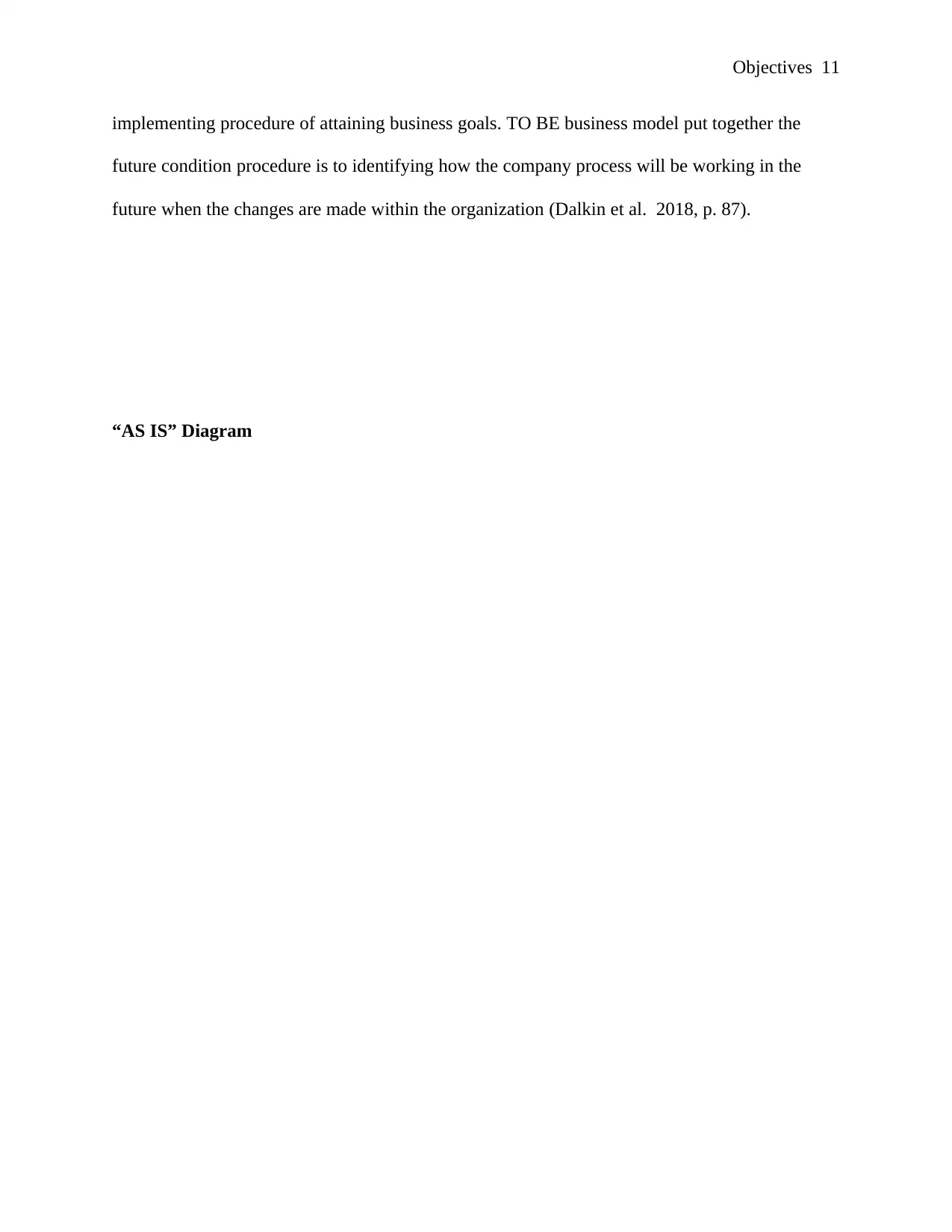
Objectives 11
implementing procedure of attaining business goals. TO BE business model put together the
future condition procedure is to identifying how the company process will be working in the
future when the changes are made within the organization (Dalkin et al. 2018, p. 87).
“AS IS” Diagram
implementing procedure of attaining business goals. TO BE business model put together the
future condition procedure is to identifying how the company process will be working in the
future when the changes are made within the organization (Dalkin et al. 2018, p. 87).
“AS IS” Diagram
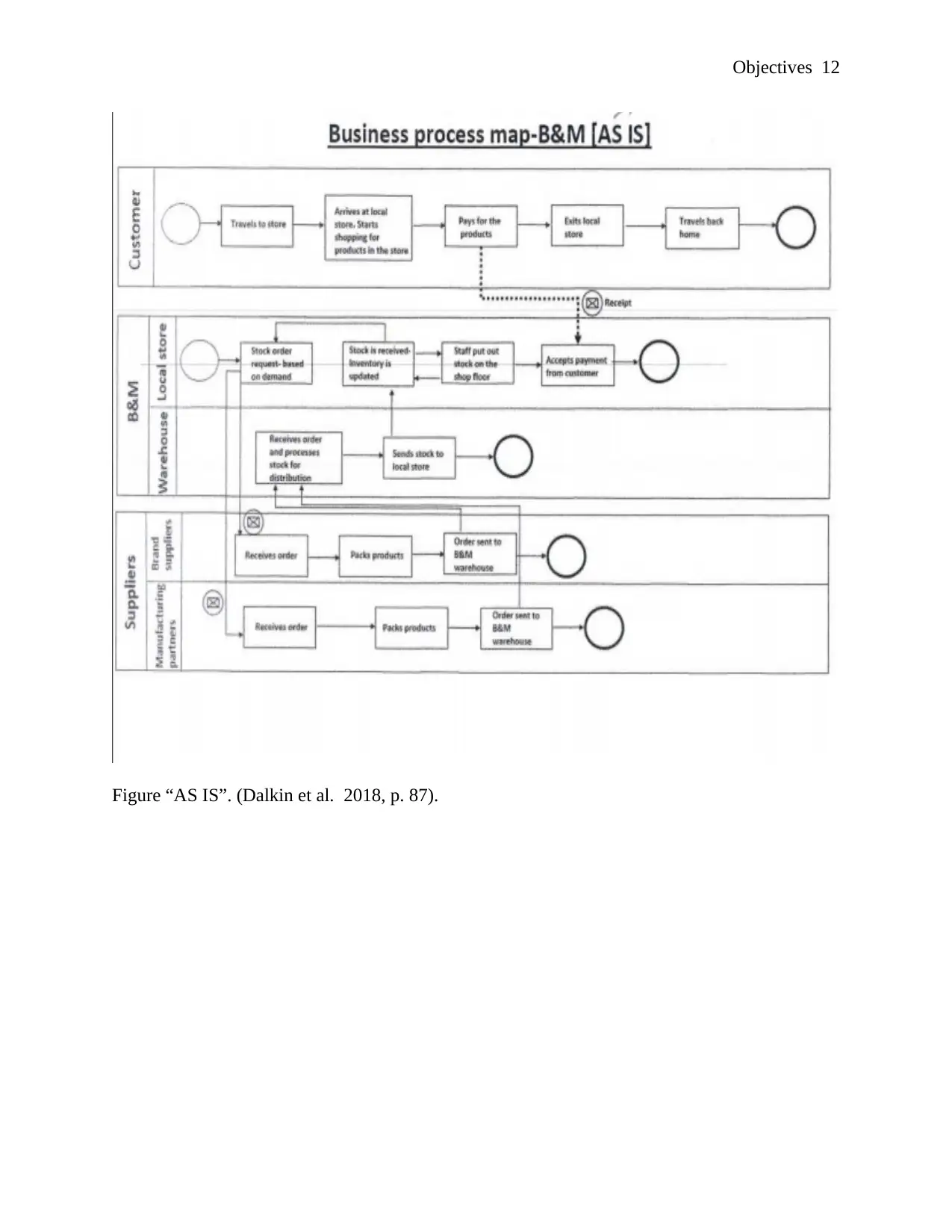
Objectives 12
Figure “AS IS”. (Dalkin et al. 2018, p. 87).
Figure “AS IS”. (Dalkin et al. 2018, p. 87).
⊘ This is a preview!⊘
Do you want full access?
Subscribe today to unlock all pages.

Trusted by 1+ million students worldwide
1 out of 26
Related Documents
Your All-in-One AI-Powered Toolkit for Academic Success.
+13062052269
info@desklib.com
Available 24*7 on WhatsApp / Email
![[object Object]](/_next/static/media/star-bottom.7253800d.svg)
Unlock your academic potential
Copyright © 2020–2025 A2Z Services. All Rights Reserved. Developed and managed by ZUCOL.




